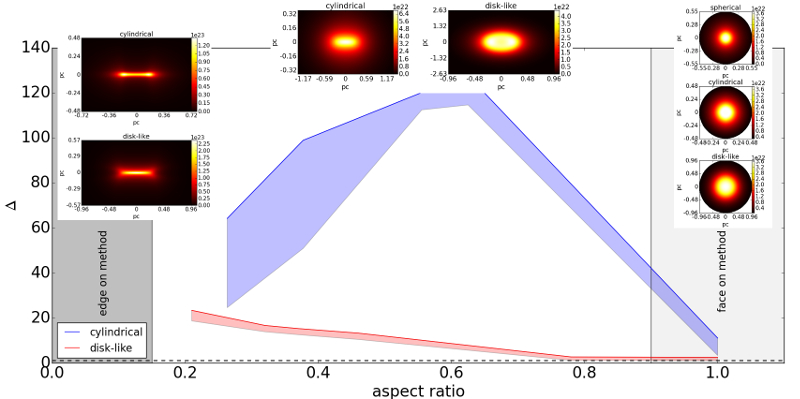| EPoS Contribution |
|
Interstellar Chemistry: A useful ally in the quest for the true shape of prestellar cores
Aris Tritsis UoC, Heraklion, GR | |
|
Two dimensional projections on the plane of the sky, as probed by dust
emission maps, can be identical for different intrinsic 3D core shapes.
However, this is not true for the two dimensional projections
of cores when seen through the chemical lens. Therefore, molecular
column density maps can be used to deproject prestellar cores and probe
their true 3D shape. We have employed hydrodynamic simulations of
contracting, isothermal cores considering three intrinsic geometries:
spherical, cylindrical/filamentary and disk-like. We have coupled our
hydrodynamic simulations with non-equilibrium chemical modeling. We
then considered various orientations with respect to the line-of-sight.
We find that: a) edge-on, when cores are seen as filamentary objects in dust emission (apparent aspect ratios < 0.15), disk-like cores manifest themselves as two parallel filaments in N2H+ column density maps; b) if cylindrical and disk-like cores are projected such that they are observed as ellipses in dust emission (apparent aspect ratios 0.15 ~ 0.9) we define a metric Δ that quantifies whether a molecular column density profile is centrally peaked, depressed or flat. We have identified one molecule (CN) for which Δ as a function of the apparent aspect ratio is an excellent discriminator between intrinsic 3D shapes; and c) for cores with almost circular projections (i.e. for apparent aspect ratios ~ 1), we have identified three molecules (OH, CO and H2CO) that can be used to probe the intrinsic 3D shape by close inspection of their molecular column density radial profiles. We have demonstrated that our method is robust against the choice of parameters, resolution and radiative transfer effects. | |
 | |
| Caption: Inset figures depict the degeneracy of different intrinsic shapes seen in dust emission for different projection angles. The main plot shows a parameter "Delta" quantifying the amount to which the column density of CN is peaked as a function of the apparent aspect ratio for disk-like and cylindrical models (red and blue shaded regions respectively) for different resolutions. The horizontal dotted line is at Δ = 1 (flat). For disk-like models Δ is close to unity, especially for aspect ratios > 0.6 whereas for cylindrical models the value of the parameter Δ is much greater than 1 for all aspect ratios. | |
| Collaborators: K. Tassis, UoC/IESL, Greece K. Willacy, JPL, US |
Suggested Session:
Cores and Collapse |

